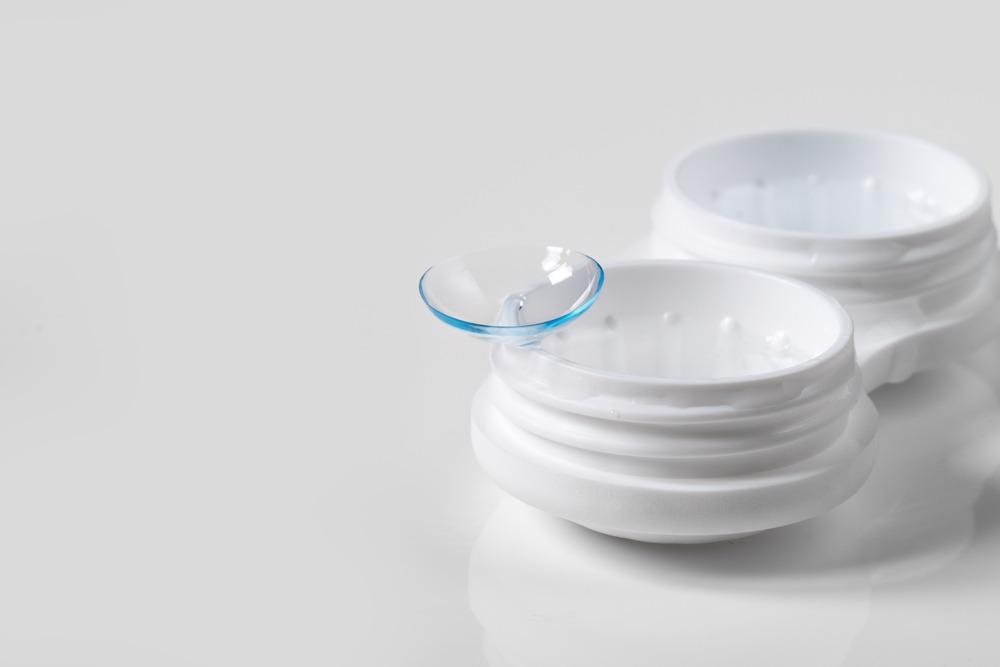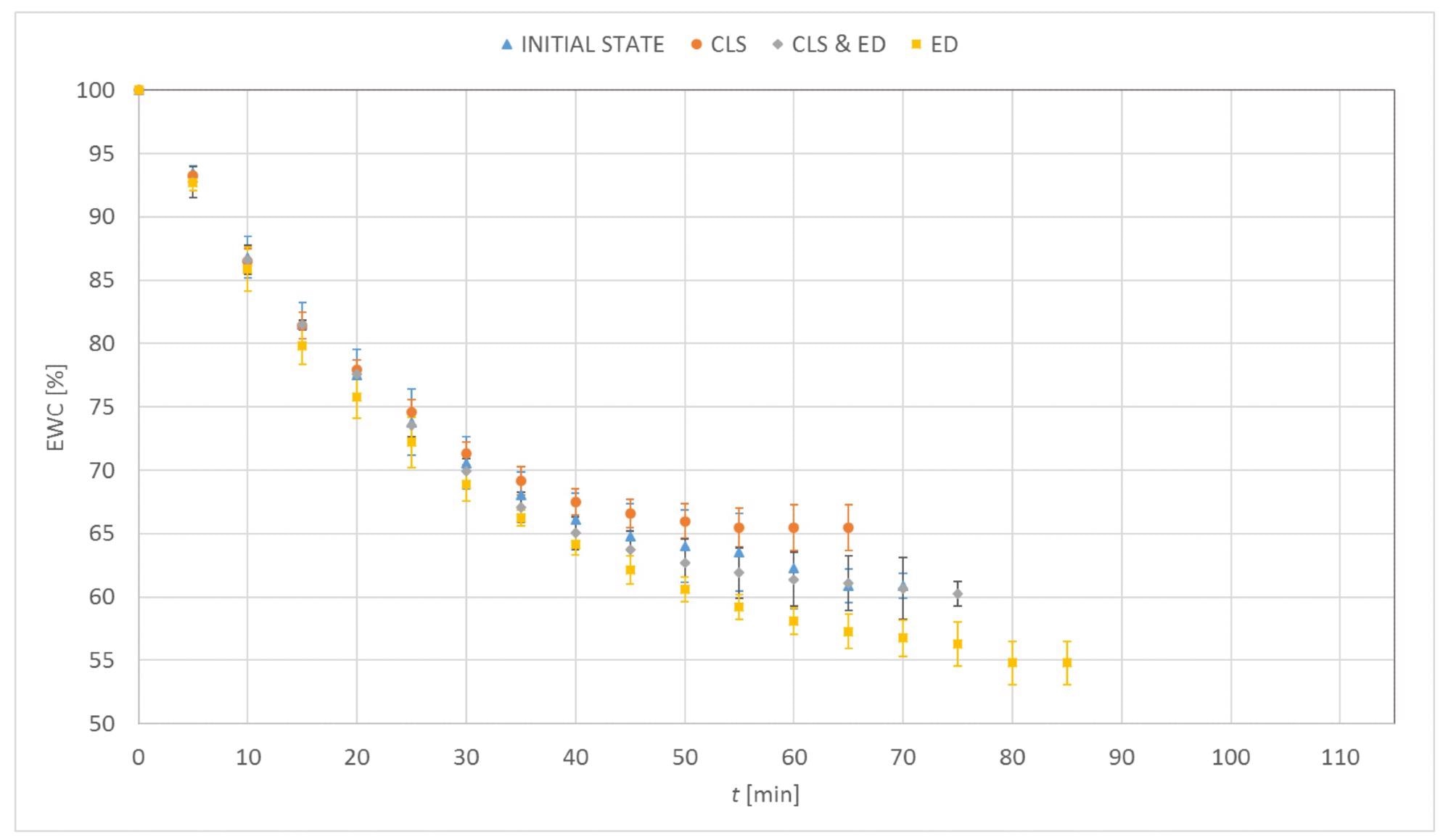In a recent study published in the journal Materials, researchers from Poland analyzed the incubation effect in certain ophthalmic fluids on contact lenses.

Study: Influence of Selected Ophthalmic Fluids on the Wettability and Hydration of Hydrogel and Silicone Hydrogel Contact Lenses—In Vitro Study. Image Credit: Tatiana Kochkina/Shutterstock.com
Contact Lens and Wearers Discomfort
The majority of contact lens wearers complain about the discomfort caused by dry eyes, which may be caused by factors such as protein adsorption or friction during blinking. Moreover, about half of contact lens wearers experience dry eye symptoms, and 25% of eye patients discontinue wearing contact lenses due to dry eye complications. The need to improve the comfort of contact lenses is currently driving the development of novel optical materials used in lens manufacturing.

Different cases of liquid contact angle on surfaces specifying wettability: (a) high wettability, (b) medium wettability, and (c) low wettability. Image Credit: Chwalik-Pilszyk, G et al., Materials
The objective of the current research was to see how contact lens solution (CLS) and the hyaluronan eye drops affected the dehydration process and surface properties of commercially available hydrogel and silicone hydrogel-based contact lenses.
The dehydration process was calculated using the gravimetric method, and the dehydration rate and equilibrium water content (EWC) were also determined. Furthermore, the surface free energy (SFE) was calculated by contact angle measurements, which determined the character of the materials' surface.
Methodology
The researchers in the current study examined four commercial contact lens materials: hydrogel (Etafilcon A and Omafilcon A) along with the silicone hydrogel (Narafilcon A and Senofilcon A). All of the lenses used by the researchers were of 2.50 D back vertex power to avoid the effect of variations in contact lens cross-sectional area on the dehydration studies. Researchers prepared all the contact lens samples according to the same protocol for optimal experimental conditions.
The researchers used tweezers to remove the contact lens from the storage solution, touching only the sides of the lens and being careful not to contaminate the material. After that, the samples were rinsed in saline and either tested right away or placed in the contact lens incubated solution to prevent degradation. Post removing the contact lenses from the incubation solution, they were placed in a convex plastic holder. To replicate the conditions of the eye, the contact lens' curvature was kept similar to the radius of the eyes.
The wettability was determined using contact angle (CA) tests, and SFE values were also calculated. The measurements were made using an optical goniometer and software added with the sessile drop method.

Distribution of equilibrium water content values as a function of time for Omafilcon A. Image Credit: Chwalik-Pilszyk, G et al., Materials
Results
Contact lenses incubated in eye drops (ED) showed the most significant changes in the dehydration profile. The most noticeable changes in CA properties were observed for contact lenses incubated in ED, where water drop settlement was impossible after incubation.
The SFE analysis demonstrated higher values for hydrogel contact lenses. Based on the Owens–Wendt method, the SFE ranged from 54.45± 6.56 to 58.09 ±4.86 mJ/m2 for hydrogel contact lenses and 32.86 ±3.47 to 35.33± 6.56 mJ/m2 for silicone-hydrogel contact lenses.
Moreover, incubation in all of the hydrogel contact lenses in ED showed a reduction in SFE values, but the differences were statistically insignificant.
The Owens–Wendt, Wu, Neumann, and Neumann–Kwok methods were used for SFE calculations by the researchers. The SFE values calculated using all these methods were similar; however, the values obtained using the Wu method were higher than those calculated using the other models. Further, the researchers also used the student's t-test for two-group cases and the one-way analysis of variance (ANOVA) for hypothesis testing.

Water contact angle measurement for Narafilcon A. Image Credit: Chwalik-Pilszyk, G et al., Materials
Conclusions
The present study findings demonstrated how different ophthalmic fluids affect contact lens dehydration, wettability, and surface properties. Moreover, the distinctions in the molecular structure of the miscellaneous materials studied by the researchers can explain differences in contact lens dehydration profiles. One key limitation of the study is that the research looked at the effects of only one contact lens solution and one type of eye drop on the lenses' properties.
The researchers combined the SFE studies with dehydration studies to give the contact lenses material a broad characterization. Additionally, the SFE calculations were also helpful because they could estimate the possibility of bacterial adhesion on contact lens surfaces.
Maintaining the wettability of contact lenses over a more extended period is clinically essential for maintaining eye health and wearer comfort. In addition, in vivo studies are needed to better understand the clinical impact of ophthalmic fluids on contact lens surface properties, wettability, and dehydration.
Future research should focus on examining SFE taking into account factors such as bacterial adhesion, oxygen permeability, and dehydration under different airflow and humidity conditions.
Disclaimer: The views expressed here are those of the author expressed in their private capacity and do not necessarily represent the views of AZoM.com Limited T/A AZoNetwork the owner and operator of this website. This disclaimer forms part of the Terms and conditions of use of this website.
Source:
Chwalik-Pilszyk, G.; Wis'niewska, A. Influence of Selected Ophthalmic Fluids on the Wettability and Hydration of Hydrogel and Silicone Hydrogel Contact Lenses—In Vitro Study. Materials 2022, 15, 930. https://www.mdpi.com/1996-1944/15/3/930